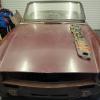-
Content Count
8,948 -
Joined
-
Last visited
About RobH

- Currently Viewing Online User List
Profile Information
-
Location
Newbury, Berkshire
-
Cars Owned:
TR3A
MG M type
ex-TR7
ex- AH Sprite
ex- Saab 900turbo
ex- an assortment of 'grey porridge'
Recent Profile Visitors
4,482 profile views
-
I understand that this is due to the cursory way the survey is often done these days- basically just a tick-the-box form from a quick visual, sometimes even just from photos rather than a physical check. The person doing the survey is paid by the insurance company and time is money. You don't have to accept what the insurance company says and can challenge the assessment but you would need to hire your own engineer to do another survey and prepare a report. I'm not sure how that would work if you don't actually own the car though.
-
Another thing you will need to change if you are swapping polarity is the instrument voltage stabiliser if that is a modern electronic type rather than the original bimetallic. You can get away with not changing the wiring on the control box as long as you just insulate the dynamo ends of the dynamo leads and take off the earth connection from E on the control box. The box can't then do anything even though it remains connected. You would need to connect the alternator field wire to D so it picks up the ignition lamp connection and find a way of connecting the alternator outpu
-
This is one way to do it using the RB106 as a junction box with its internals removed and the three large spade terminals A1, A and D connected together with a heavy gauge link wire under the base. There is no connection to E. F is used just as a junction point. (Note that the D and F terminals are shown in the wrong order, for clarity in the drawing )
-
To be honest that looks more of a crack than anything. The ends don't look melted. There is blackening at the LH end of that link though.
-
The choke mechanism certainly shouldn't be wet with fuel - and neither should the vacuum advance pipe. These are possibly signs of the jet overflowing due to too high a fuel level in the float chamber. If the mixture is way too rich the engine won't fire.
-
If you couldn't see any fuel in the jet it might be a clue as to why the engine stops Nick. Perhaps it has used up all that was there? You can usually see the glint of the liquid if you shine a torch down the hole. The float chamber might be full but if fuel isn't getting through to the jet properly, it can't run. After all, that is the thing you have been working on and sudden onset of a new fault afterwards might be a pointer to all not being well.........?.
-
Two things David. The fuse should go as close as is reasonable to the power pick-off point and the starter solenoid is a good place only if you have no ammeter. If you do have one, it will register the lighting current as a 'charge' which is incorrect, so in that case the pick-off should be directly where the alternator output cable connects. A 15 Amp fuse is fine - a fuse should be rated slightly lower than the cable it is protecting, though in this case since the lights draw a lot less current you could go even lower if you wanted.
-
That mod is only to reduce voltage drop on the switch Keith - it adds no protection whatever to the existing wires. Relays in the main lamp supply won't help you if the wires before the relay coils short to earth anywhere. There may be less current flowing there when all is OK but a short circuit to earth will still pull all the current it can through those wires. Only a fuse can save the loom .
-
A Durite 0-727-12 is the modern type or a part number 140201 here: https://www.autoelectricsupplies.co.uk/p/12-volt-relay-make-and-break If you go to a local shop ask for a "4-terminal 30amp make-break relay" For modern relays the connection terminals are numbered rather than letters and the equivalents to the original are: C1=30. (brown/white wire), C2=87 (yellow/purple), W1=86 (white), W2= 85 (yellow/green)
-
You seem unsure whether the battery is being charged - what does the ammeter show? As Bob says, 12v should be present on 'A' all the time If it isn't it's likely the heavy-current loop inside the ammeter has become detached.
-
I guess this is for an early car with ammeter - are you looking to replace the wires? The larger wire which goes to the ammeter carries the peak battery charging current which can be 30A or more. A suitable wire for that would be 84/0.3 rated at 42A, to give some margin. The smaller wire basically just carries the horn current which peaks around 10A and the hazard flashers at 7A plus maybe a few other things if the car is a US model. A suitable wire size is 44/.30 (27.5A rating).
-
The rattle could just be that the gearstick anti-rattle plunger isn't there Richard, as others have said. The name is the clue. If the OD relay clicks only when the gearbox is in gear, the two interlock switches are working as they should. This is a direct UK-source replacement relay: https://www.ebay.co.uk/itm/164379224543 At that price it's worth making sure you really need one !
-
Have you removed the carb piston chamber and looked at the fuel level in the jet Nick? That's the important thing. It should be a short way down from the top (not critical - 1/8 to 1/4 inch is fine). The wetness you describe sounds like it could be overflow from too high a level. The starting problem you describe could be a grossly (!) over-rich mixture due to that.



